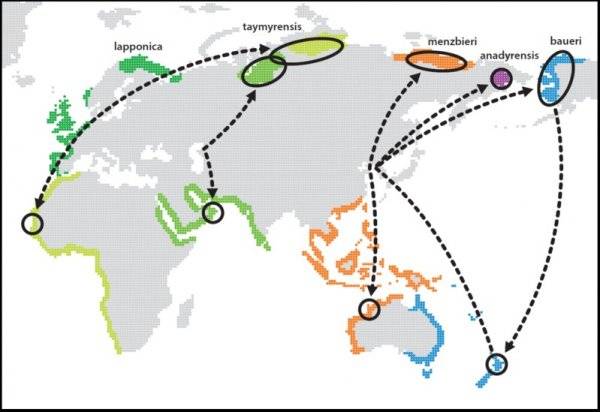World Migratory Bird Day: Bar-tailed godwit

The different migration routes used by Bar-tailed Godwits (Jesse Conklin at TeamPiersa.org)
With distribution and migration routes across many areas of the planet with vastly differing climates, the Bar-tailed Godwit Limosa lapponica is certainly a wading bird worth looking at in more detail. A heavily built wader, a member of the Sandpiper and allies family, its long and sturdy legs and bill are designed for probing into mud and shallow water for snails, insects and worms. They are hard to overlook when seen next to significantly smaller fellow wader species through binoculars or telescope. Chestnut red breeding plumage on the front and legs gives way to a duller light brown and white wintering plumage, with even the bill changing colour from black to light pink. A notable identification feature is a white patch stretching from the rump to the back, getting narrower as it goes up to end in a point. Confusion can only take place with the Black-tailed Godwit Limosa limosa, its key differences are black and white striping on the wing, longer legs and black striping on the belly in breeding plumage.
Areas of the high artic are the chosen breeding grounds of the Bar-tailed Godwit, specifically northern Scandinavia, Russia, Siberia and Alaska. With such a wide distribution, four subspecies are scientifically recognised, using different migration routes, as shown in the image above.
The route within the remit of OSME’s is shown in dark green. From high in northern Russia, the birds fly over vast expanses of ‘taiga’ forest before reaching an obvious stop off point, the Caspian Sea, the largest enclosed water on the planet. Despite being cut off and being fed through freshwater sources, the water retains a high salt content. Conservation work on the east coast of the Caspian Sea, specifically in Kazakhstan and Turkmenistan, is clearly an important piece of the puzzle in the preservation of the flyway.
Having experienced an increase in temperature as the route moves ever further south, the next, for some final, stop off point will certainly be a shock to the system if individuals can remember the start of their journey. Bar-tailed Godwits settle on both the Oman and Iranian coasts, whilst others move further east into Pakistan. Here they settle for the winter before heading north in the spring once the worst of the cold weather has subsided for breeding.
The wonders of modern technology and tracking data now make it much easier for conservationists to identify the key areas to protect and an increasingly international approach means migration routes are being prioritised. Let us hope that this continues to be the case and you can play a part by supporting organisations such as OSME as they put in the groundwork to ensure bird migration are preserved and are there for many future generations of Bar-tailed Godwits and a wealth of other species.
Written by James Walker
